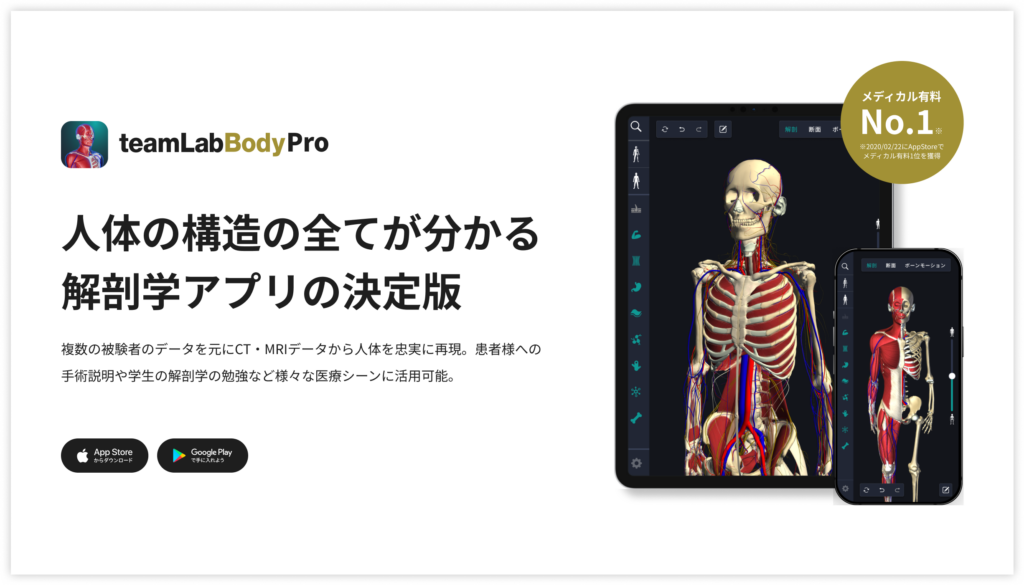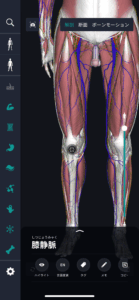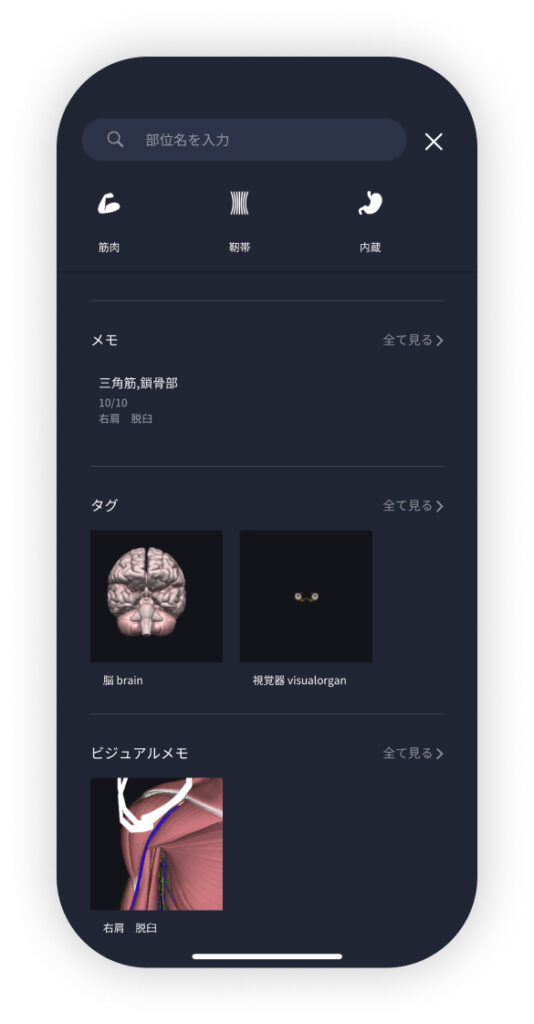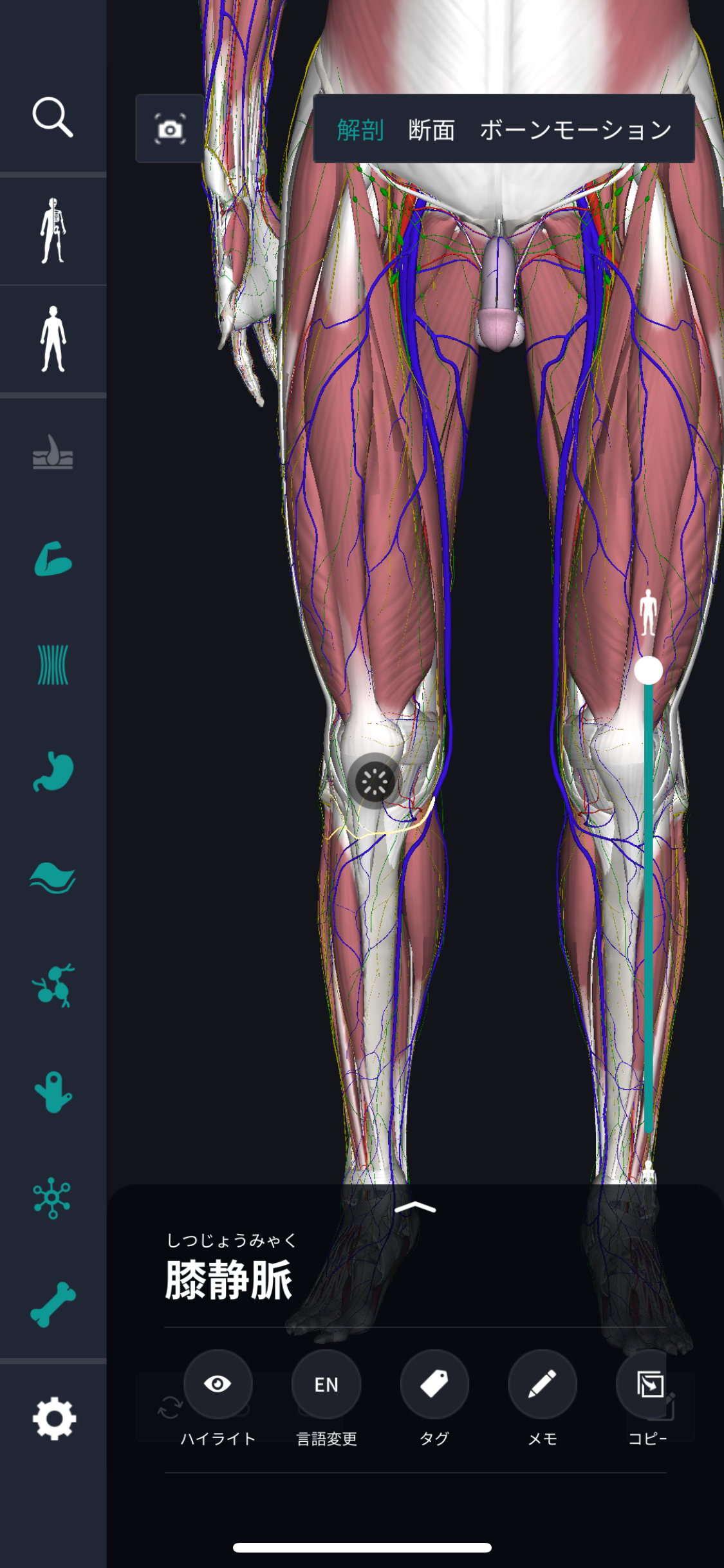beginning
In this article, I will explain effective study methods, starting with knowledge of specialized parts in human anatomy.
In human anatomy, it is necessary not only to memorize the names of various organs, muscles, and bones, but also to remember where they are located in the body. Therefore, it is necessary to learn as efficiently as possible.
I hope you can read this article and use the app to deepen your understanding even a little bit.
Now, I'll explain the details about the “knee vein” and how to study human anatomy.
teamLab Body Pro Free Download
A 3D anatomy app that shows all the structures of the human body
Download teamLab Body Pro here!

What is the Knee Vein?
In the anatomy application, you can view a selection of anatomy 3D models. In this model, there are various observation methods such as surfaces, cross-sections, and nervous systems. This time, I'll explain using an anatomy application.
About the knee vein

The knee vein is an important route for blood to circulate in the lower extremities and is anatomically located at the back of the knee. Specifically, the popliteal artery (popliteal artery) and popliteal vein (popliteal vein) pass behind the knee and continue upward to the femoral artery and vein. The popliteal vein takes almost the same route as the popliteal artery and plays a role in returning blood from the lower limbs to the heart. The popliteal vein collects at the back of the knee while accepting a wide range of branch veins, thereby making venous blood flow smoothly. Mainly, the anterior tibial vein, and posterior tibial vein join the popliteal vein and advance further upward via the popliteal vein. These are collectively called the popliteal vein group. Also, the knee has popliteus muscle (popliteus muscle), and this muscle is involved in knee flexion and also plays a role in preventing compression of veins and promoting blood flow. The popliteal region is protected by muscle and adipose tissue to protect the veins from friction and trauma associated with knee joint movement. Furthermore, the structure of the popliteal vein is equipped with a valve to prevent venous reflux. These valves control the unidirectional flow of blood and prevent gravitational backflow. This valve function is particularly important in everyday activities such as walking and running. The health of the venous system in knee anatomy can affect overall circulatory health, and its structure and function are critical for maintaining the knee's range of motion. Understanding this venous network, which includes the popliteal vein, has an important place in anatomical knowledge.
Study points
The location and structure of the knee vein
The knee vein plays an important role in blood circulation in the lower extremities and is a vein that runs through the back of the knee. The popliteal vein is located behind the knee and is part of the path that returns venous blood from the lower leg to the heart. This vein continues upward to the femoral vein and takes part in the flow of blood from the thigh. Structurally, the popliteal vein is equipped with valves, which prevent blood from flowing back and help blood flow in one direction against gravity. The popliteal vein collects branch veins such as the anterior tibial vein, posterior tibial vein, and fibula vein, and ensures efficient blood flow by aggregating these. The posterior part of the knee contains popliteal muscles and adipose tissue that protect the veins, and this protects the veins from external impact and friction. The popliteus muscle prevents compression of the veins in response to knee exercises and supports smooth blood flow. Thus, the location and structure of the knee vein maintains venous blood circulation and plays an important role in lower limb health.
The role and function of the knee vein
The primary role of the knee vein is to direct venous blood from the lower extremities back towards the heart. The popliteal vein, which runs through the back of the knee, functions as part of an important blood vessel that collects venous blood and carries it upward. Since it is necessary to push blood back against gravity in daily life or during exercise, valves are arranged to prevent backflow, and this function supports efficient blood flow. The venous system can circulate blood containing oxygen and nutrients throughout the body through enhanced blood circulation. In particular, during knee exercises, the function of the popliteal muscle is important, and by properly compressing the veins, this muscle promotes blood circulation and prevents venous blood stagnation. This also helps prevent varicose veins and thrombosis due to lack of exercise or prolonged sitting. In addition, maintaining a healthy venous system supports muscle contraction and is essential for maintaining healthy overall body function through oxygen supply to tissues and efficient removal of waste products. For this reason, the knee vein can be said to be an essential element for maintaining the circulatory system of the lower extremities.
English notation for knee vein
I will explain in detail “popliteal vein,” which is the English notation for knee vein. The word “popliteal” is an anatomical term associated with the back of the knee, that is, the popliteal region. This refers to the depression behind the knee and is known as an anatomically important area. “Vein” means a vein, and it is a blood vessel that has the role of returning blood to the heart. Thus, the expression “popliteal vein” indicates a specific vein that runs through the back of the knee, and is frequently used, especially in the medical field, when evaluating problems or diseases related to blood flow in this area. This English notation is very important for conveying accurate and clear information in anatomy and pathology.
How to study human anatomy
I will explain specific study methods using human anatomy applications.
Check your past learning history and practice repeatedly
Here are the steps to check your anatomy learning history and practice iteratively effectively.
1. Check your learning history in the app
Reviewing your learning history with the application is an important step in effectively advancing anatomy learning. First, launch the app and go to the learning history section from the main menu. Many anatomy apps are designed to show your progress in the form of graphs and lists, so you can visually check which parts you've learned about and how much time you've spent.
By using this data, you can understand which areas you have strengths in and where you need to spend more time and effort. We also recommend using a dedicated tag or notebook function to mark areas you are particularly weak at or where you need to relearn. Regularly checking your learning history and looking back on past learning content will lead to efficient review and deepening understanding.
2.Make a plan for iterative learning
Making an efficient repetitive learning plan based on learning history is extremely effective in promoting knowledge retention. First, identify weak points and areas where you need to relearn. Next, arrange these study items into a weekly or monthly calendar and create a specific study schedule. By proceeding in a planned manner, you can learn each part evenly and avoid packing in a large amount of information at once.
Using a task management app or digital calendar to set study reminders is effective. Also, it's important to have the flexibility to regularly review progress and revise plans as needed. By having goals and proceeding with your studies in a planned manner, you can efficiently acquire anatomical knowledge.
3.Use 3D features to learn visually
By utilizing the 3D function, learning anatomy is easier to understand visually. The 3D model shows the structure of the human body three-dimensionally, and each part can be observed in detail. This makes it possible to intuitively grasp positional relationships between deep muscles and organs that are difficult to capture in a planar view. For example, you can learn even the smallest details by rotating specific muscles and bones and zooming in and out.
Also, there are many apps that have the function of displaying cross-sectional views of each part using a 3D model, which is useful for deepening understanding of internal structures. This diversity of visual information helps with memory retention and improves immediate responsiveness in tests and practice situations. By utilizing the 3D function and learning visually, you can learn anatomy knowledge more deeply and efficiently.
Use the memo function concretely

Make notes so you don't forget the things and points you've noticed while studying. The memo function can be used for different purposes, such as inputting text, saving images, and writing memos. Tag your notes to make them easier to review later.
Test your learning regularly in the form of quizzes
Regularly testing what you've learned in a quiz format is a very effective way to anchor your anatomy knowledge. Quiz-style tests help you objectively grasp your level of understanding and areas you lack while repeating knowledge.
For example, by using a learning app to conduct quizzes every specific period, you can reconfirm what you've learned and strengthen your memory. There are a wide range of quiz formats, such as multiple choice questions, fill-in-the-blank questions, and short answer questions, and each helps understanding from a different angle and develops the ability to utilize various types of knowledge.
Get feedback
If possible, get feedback from other learners and experts. It helps you find your own gaps in understanding and areas for improvement. You can also keep yourself motivated to learn by regularly testing yourself. Feeling a sense of accomplishment and progress increases motivation for continuous learning.
summary
This time, I explained how to study about the “knee vein” using an application!
Thank you for reading this far.
I would be happy if reading this article helped you learn about anatomy.
Learning is a long, never-ending journey, but I sincerely wish you all the best. Let's continue to study together and work hard for the national exam!
Please look forward to the next blog.




